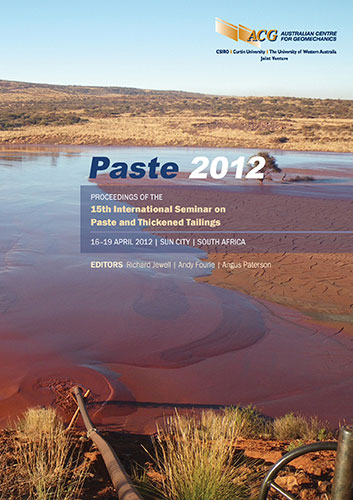Application of hydrocyclone technology to tailings storage facilities to reduce water consumption

|
Authors: Knight, MA; Wates, JA; Du Plessis, I |
DOI https://doi.org/10.36487/ACG_rep/1263_20_Knight
Cite As:
Knight, MA, Wates, JA & Du Plessis, I 2012, 'Application of hydrocyclone technology to tailings storage facilities to reduce water consumption', in R Jewell, AB Fourie & A Paterson (eds), Paste 2012: Proceedings of the 15th International Seminar on Paste and Thickened Tailings, Australian Centre for Geomechanics, Perth, pp. 233-241, https://doi.org/10.36487/ACG_rep/1263_20_Knight
Abstract:
Cycloning technology is extensively used in mineral processing plants for the extraction and size separation of minerals. Cycloning of tailings storage facilities (TSFs) has been utilised successfully in South Africa as an alternative to other tailings deposition methods. In order to evaluate paste and thickened tailings disposal options against alternative methods, one should make the comparison against realistic baseline water consumption. This may require optimisation of existing operations or, alternatively, preparation of an appropriate base case that has been designed to reduce water consumption to the minimum level possible without thickening. Cycloning or classification of tailings provides an opportunity to reduce water consumption in some cases. Based on a number of actual case studies, Fraser Alexander and Multotec have worked together to develop a scientific approach for the design and operation of cyclone TSFs. The study focuses on taking cyclone practice from the mineral processing environment and combining it with TSF design thinking to optimise the design and operation of TSFs in such a manner as to optimise classified tailings production and to reduce water consumption as far as possible. The approach is based on theoretical assessment, laboratory test work, field tests and observations and operational experience in managing TSFs. The approach consists of the following steps: The paper will use a case study to illustrate the influence of variables such as rate of rise, cyclone split, and feed slurry solids concentration on the design of aspects of cyclone TSFs and on performance with respect to water consumption and recovery.
References:
Davel, K. (2011) Mine Waste Solution Bi-monthly Reports, created for First Uranium, by K. Davel, Johannesburg (confidential, cited with permission).
Plitt, L.R. (1976) A mathematical model of a hydrocyclone classifier, CIM Bulletin, December 1976, Vol. 69 (776), pp. 114–123.
Robinson, B. (2010) The fundamentals of on-wall cyclone tailings dams, presented at Tailings Disposal Course on behalf of Fraser Alexander, October 2010.
Wates, J.A. (1983) The Disposal of Mine tailings: The Real Cost of Excess Water in Residues, Journal of the South African Institute of Mining and Metallurgy, November/December 1983.
Wills, B.A. and Napier-Munn, T.J. (2007) Mineral Processing Technology, Butterworth-Heinermann, pp. 212–223.
© Copyright 2025, Australian Centre for Geomechanics (ACG), The University of Western Australia. All rights reserved.
View copyright/legal information
Please direct any queries or error reports to repository-acg@uwa.edu.au
View copyright/legal information
Please direct any queries or error reports to repository-acg@uwa.edu.au